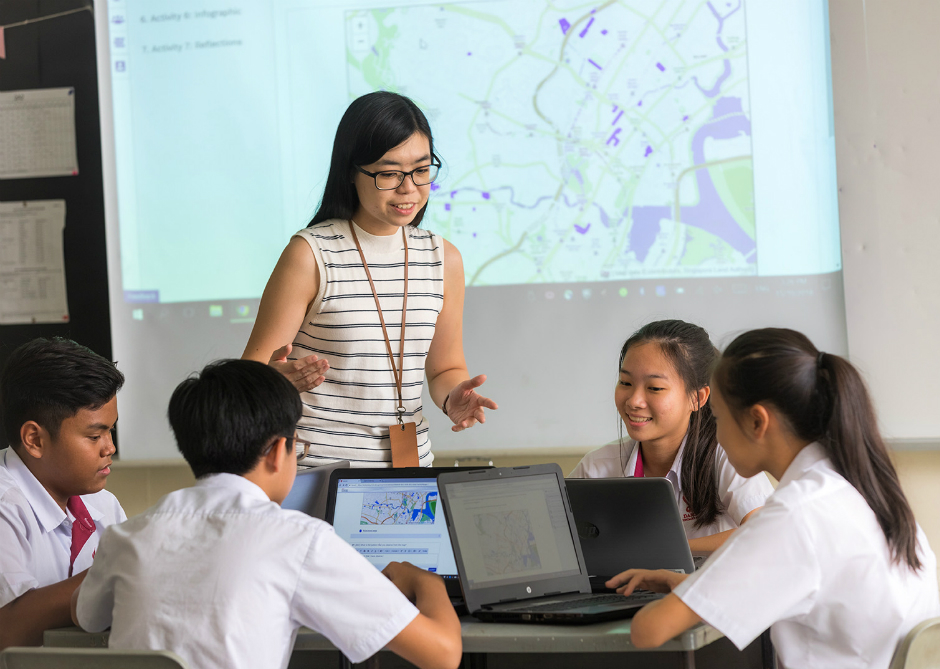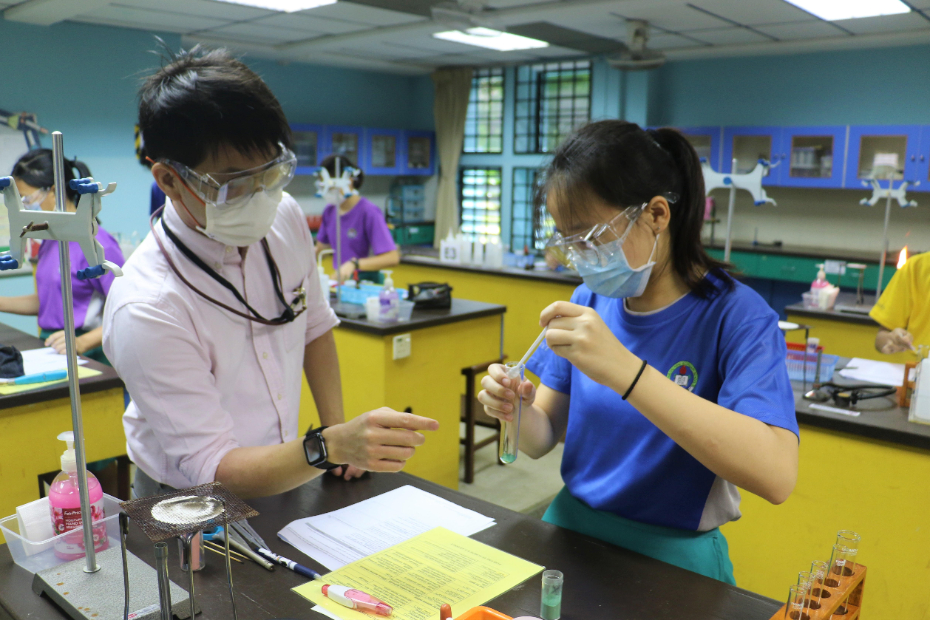By Ms Tay Yinmin, Geography and Mathematics Teacher, Damai Secondary School
With the recent spate of rainy days, I thought up an unconventional get-out-of-the-classroom opportunity for my student geographers to examine authentic flood control strategies in the school.
I wanted my Sec 2 students to think about the locations in school that were more likely to flood, and why? What were the crisis control strategies that had been implemented in the school? How effective were these strategies?
Enter the Student Learning Space
First, to understand how flood management strategies help to reduce flooding, my learners watched curated videos on the Singapore Student Learning Space (SLS). The stimulus videos enabled them to learn at their own pace as they could pause the video and re-watch any segment, allowing their curiosity free rein.
 Armed with tablets, students investigate flood control strategies in their school.
Armed with tablets, students investigate flood control strategies in their school.
They then walked around the school to observe the environment for elevated properties, vegetated surfaces and widened and deepened channels. They photographed and described these factors and recorded all the data on their tablets.
Back in the classroom, applying what they had learned from the videos, the students analysed the observations that the class had gathered – all easily accessible via SLS – and evaluated the pros and cons of the physical factors. Each group then discussed before arriving at a consensus as to whether the flood control for a selected site was working.
Justin Tan, a Secondary 2 student, shared with the class later, “Learning Geography this way makes me see how the subject is relevant to the real life. This motivates me to want to find out more about the world around me!”
Reading Each Other’s Thoughts
As my students had different opinions about the strategies, they also learned to communicate their views effectively to others, and eventually crafted a group response to be posted on the SLS platform. I find this is a good way to encourage collaboration and ownership of their knowledge.
Chloe Lim, a student in my Secondary 2 Geography class, told me, “I love how I can ‘peer’ into my friends’ thoughts on the Thinking Routine wall when my teacher flashes that on the screen! My friends and I also like to share our responses in the Polls and Quizzes.”
This insight from the Thinking Routine feature on SLS is also valuable to me as “live” responses can be viewed in real-time in class. Mistakes or misconceptions in students’ responses can be immediately addressed while perceptive ideas can be discussed.
I was particularly impressed when I read one of their responses to the “See-Think-Wonder” thinking routine: “What can we do to prevent floods in an area crowded with concrete structures?” This showed me that the students were able to relate the lesson to their personal context.
SLS helps me to better engage and connect with each and every one of my students – even those who might otherwise be too shy to speak up. For example, a student, who was usually reserved and rather passive, began to speak up and even initiate ideas after a couple of guided group work activities in SLS.
 “Technology is a means for us to enhance our teaching,” says Ms Tay.
“Technology is a means for us to enhance our teaching,” says Ms Tay.
Technology – Working Behind the Scenes
Being digital natives, my students are more engaged when I use videos and simulations on SLS to help them visualise and discuss difficult concepts. As the lesson designer, my role is to select and scaffold the resources to suit the learning needs of my students — for effective learning to take place.
We’re also encouraged to open up our classrooms to our colleagues here at Damai. The open classrooms give me the opportunity to think about the interactions taking place. I saw first-hand how other teachers encourage their students to learn, create meaning and interact with one another. This allows me to reflect on my own approaches and encourages me to try new teaching moves.
In turn, when I open up my classroom, I receive valuable feedback from my colleagues that help me to refine my instruction and improve my lessons. In this safe environment where I learn, share and grow, I know that I’m not alone.
This makes me want to create more designs on SLS to transform and deepen learning in the classroom. And as I also teach Mathematics, the fact that students can revisit past lessons anytime, anywhere, on only one platform – it makes me feel even better able to nurture and inspire their young minds.
A version of this article was originally published in Issue 32 of “Contact: The Teachers’ Digest” with the headline “Chart a Fresh Course”.






.jpg)